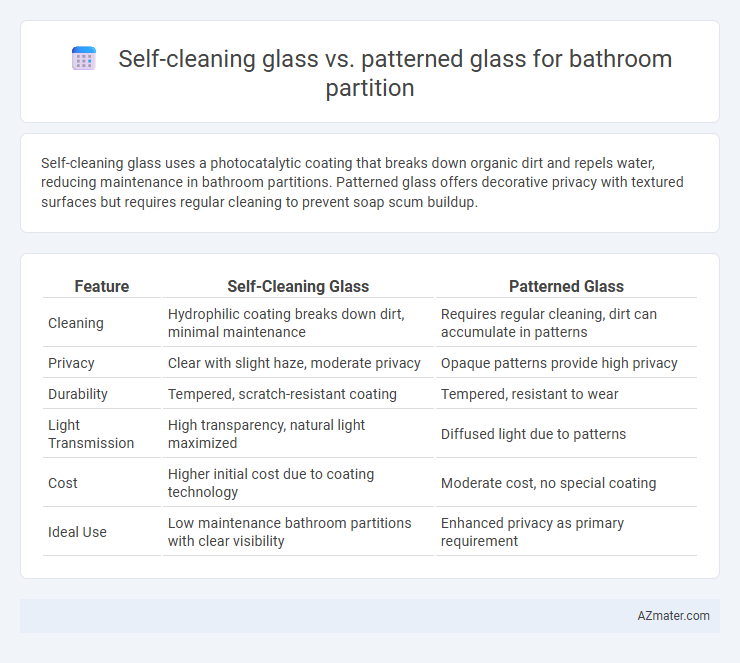Self-cleaning glass uses a photocatalytic coating that breaks down organic dirt and repels water, reducing maintenance in bathroom partitions. Patterned glass offers decorative privacy with textured surfaces but requires regular cleaning to prevent soap scum buildup.
Table of Comparison
| Feature | Self-Cleaning Glass | Patterned Glass |
|---|---|---|
| Cleaning | Hydrophilic coating breaks down dirt, minimal maintenance | Requires regular cleaning, dirt can accumulate in patterns |
| Privacy | Clear with slight haze, moderate privacy | Opaque patterns provide high privacy |
| Durability | Tempered, scratch-resistant coating | Tempered, resistant to wear |
| Light Transmission | High transparency, natural light maximized | Diffused light due to patterns |
| Cost | Higher initial cost due to coating technology | Moderate cost, no special coating |
| Ideal Use | Low maintenance bathroom partitions with clear visibility | Enhanced privacy as primary requirement |
Introduction to Bathroom Glass Options
Self-cleaning glass for bathroom partitions offers a hydrophilic coating that breaks down organic dirt and allows water to rinse away residues, significantly reducing maintenance. Patterned glass, featuring textured or frosted designs, provides privacy while enhancing aesthetics and diffusing light within the bathroom space. Choosing between self-cleaning and patterned glass depends on priorities such as ease of maintenance versus decorative privacy solutions.
Understanding Self-Cleaning Glass
Self-cleaning glass for bathroom partitions features a special coating that uses photocatalytic and hydrophilic properties to break down organic dirt and allow water to spread evenly, reducing water spots and grime build-up. This technology minimizes maintenance by enabling rain or water from showers to activate the cleaning process, keeping surfaces clearer than traditional patterned glass. Patterned glass, while offering privacy and decorative appeal, lacks these advanced self-cleaning properties, requiring more frequent manual cleaning to prevent soap scum and water stains.
What Is Patterned Glass?
Patterned glass is textured or embossed glass designed to provide privacy while allowing light to pass through, commonly used in bathroom partitions to obscure visibility without sacrificing brightness. Unlike self-cleaning glass, which features a special coating that breaks down dirt and repels water to reduce maintenance, patterned glass relies on its unique surface design to enhance aesthetics and privacy. Its variety of patterns, such as rain, reed, or frosted, offers customizable options for both functional and decorative bathroom partitions.
Aesthetic Differences: Self-Cleaning vs Patterned Glass
Self-cleaning glass offers a sleek, transparent aesthetic that enhances natural light and maintains a clear, modern look with minimal maintenance. Patterned glass provides decorative textures and privacy, allowing for creative designs that can complement various interior styles while obscuring visibility. Both options serve distinct aesthetic purposes, with self-cleaning glass focusing on clarity and ease, and patterned glass emphasizing design and visual interest.
Maintenance and Cleaning Requirements
Self-cleaning glass uses a special photocatalytic coating that breaks down organic dirt and allows water to spread evenly, reducing the need for frequent manual cleaning and minimizing soap scum buildup in bathroom partitions. Patterned glass, while offering privacy through textured surfaces, requires more regular cleaning to prevent mold and mineral deposits from accumulating in the grooves, which can be more challenging to maintain. Choosing self-cleaning glass significantly lowers maintenance efforts and water spot visibility compared to patterned glass in humid bathroom environments.
Privacy Levels: Comparison and Suitability
Self-cleaning glass offers a smooth, transparent surface that provides minimal privacy, making it less suitable for bathroom partitions where discretion is essential. Patterned glass, available in various textures and opacities, enhances privacy by obscuring visibility while still allowing natural light to pass through. For bathroom partitions, patterned glass is more appropriate due to its superior privacy levels and customizable design options.
Durability and Longevity
Self-cleaning glass for bathroom partitions features a titanium dioxide coating that breaks down organic dirt and repels water, significantly reducing maintenance and enhancing durability against mold and soap scum buildup. Patterned glass, while offering privacy through textured surfaces, may trap grime within its grooves, potentially shortening its lifespan without regular cleaning. Both options provide robust features, but self-cleaning glass generally ensures longer-lasting clarity and hygiene in humid bathroom environments.
Cost Analysis: Upfront and Long-Term
Self-cleaning glass for bathroom partitions typically involves a higher upfront cost due to advanced coatings and technology but reduces long-term maintenance expenses by minimizing cleaning frequency and effort. Patterned glass, while generally more affordable initially, may incur increased upkeep costs over time as dirt and water spots accumulate in textured surfaces, necessitating more regular cleaning. Evaluating total cost of ownership shows self-cleaning glass offers better financial efficiency despite the initial premium, especially in commercial or high-usage bathroom environments.
Installation Considerations
Self-cleaning glass for bathroom partitions requires careful installation to ensure the coating remains intact and effective, often demanding professional handling and precise positioning to maintain optimal sunlight exposure for its photocatalytic properties. Patterned glass installation is more straightforward, focusing on alignment of decorative designs to enhance privacy and aesthetics, with less concern for surface treatment sensitivity. Both types require sturdy framing and appropriate sealing to prevent moisture ingress and ensure long-term durability in humid bathroom environments.
Which Glass Is Best for Your Bathroom Partition?
Self-cleaning glass for bathroom partitions offers superior maintenance ease by using a hydrophilic coating that breaks down organic dirt and eliminates water spots, reducing cleaning frequency and keeping surfaces clearer. Patterned glass provides enhanced privacy and decorative appeal through textures like rain or reed patterns, but requires regular cleaning to prevent buildup in grooves. For optimal bathroom partition performance, especially in moisture-prone environments, self-cleaning glass outperforms patterned glass by combining low maintenance with long-lasting clarity.

Infographic: Self-cleaning glass vs Patterned glass for Bathroom partition
 azmater.com
azmater.com